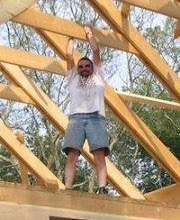I'm contemplating making the jump to electric brewing. To me it makes sense as electricity is cheaper than propane and it would allow indoor brewing. There are many things to consider though and right now I have more questions and choices than answers. I like to write things out, it helps make things clearer for me. Perhaps someone(s) out there can help?
What is electric brewing?
Using electric elements to heat your water like these:
http://www.cedarcreeknetworks.com/heatstick.htm
http://www.brewersfriend.com/2009/06/13/reducing-the-gas-by-converting-your-boil-kettle-to-electric/
The first Question.
I am a brew in a bagger. I have a 15 gallon aluminum pot that has not be drilled. I'd like to heat mash water and boil with electric. I can see making a bracket to hold an electric stick into my mash water while the bag is in and have no problems, but if I was mashing and wanted to do a mash out, could the stick be used in the mash or would I be burning grains? If that were a problem, I could see a screen device around the element keeping the grains out but allowing for contact with the liquid in kettle.
Assuming BIAB and electric can be worked out, next questions.
120V?
As I understand it, if I went 120V, I would need three or more 2000W heat sticks to get a boil. That means separate electric outlets and probably several heavy duty extension cords to bring the electricity to the brew pot. Perhaps I could get that to work at home, but I often brew with my club and I would like to be able to do the electric wherever I went, giving the host $5 to cover costs or something. No more lugging propane tank and burner has a nice sound to it.
or 240V?
If I went 240V, one 5500W would do my work. At home, no problem, unplug the dryer and plug in my electric setup and brew in my basement laundry area which is conveniently located next to my brewing supplies in my workshop. On the road, most people would have a dryer plug I could access, but we'd likely be brewing outside. Also, except for the winter, it would often be preferable to be brewing outside at my own home. So an extremely heavy duty extension cord would be in order, no? And at the probable lengths needed....$ ouch.
Thoughts.
I guess the best thought is to forget portability of the electric and use my propane burner when not at home. I would think the 240V would be the best solution, but complexity goes up a bit and I haven't found a good instruction set with wiring schematics and pictures I can follow. That setup on Brewer's Friend looks like what I'd want to do, minus drilling holes in my kettle. I was wondering if there were a way to also use the temperature control portion of it to control my freezer fermentation chamber. Could that portion of it be 120V so a standard outlet could be used? Also, perhaps the Brewer's Friend setup could be done in steps. Make a 5500W heat stick to use without the controls then later add them?
Resume.
Now for my electrical comprehension. I was an avionics technician for the Army National Guard. I can crimp, I can solder, I understand the dangers of electricity and how to be safe. I did not design things. I did not wire up new things. My work was 90% DC current, and 75% Huey 20% Blackhawk 5% other helicopters. Plenty of stereo installations. In other words, I know enough to be dangerous but not enough to do this on my own.
Any thoughts? Thanks in advance.











0 comments:
Post a Comment